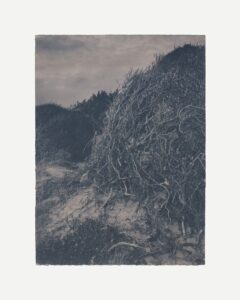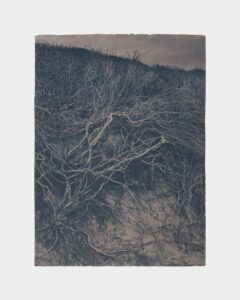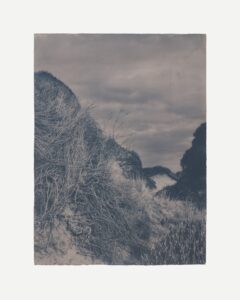Light and water. Seemingly simple, cyanotype brings photography back to ancient techniques of image sedimentation and development. “Litorali” is also an example, the exhibition by Marco Rapaccini at Il Meccanico gallery in Verona, which can be visited from 9 March to 28 April 2024. We talked about it with the artist, photographer and head of Officine Fotografiche’s educational activities.

Marco Rapaccini, “Litorali”, 2023, cyanotype, courtesy galleria Il Meccanico, Verona
Simone Azzoni: Why did you choose this printing technique, what poetic path leads you to cyanotype?
Marco Rapaccini: Cyanotype is a very simple photographic technique, which precedes most other historical techniques and has remained substantially unchanged since the mid-nineteenth century. It uses a process based on the oxidation of iron and is exposed to light very slowly, then revealed and fixed with running water. Light and water are the only elements it needs. The result is a scale of Prussian blue tones. I started using cyanotype during this work, so for me it is the technique linked to this particular research. It is a very essential technique, it is exposed by evaluating the times by eye, then it is developed to obtain the blue, which is then whitened and toned to obtain different tones, black and brown. It is a process of sedimentation and erosion that forms the image, which eventually stabilizes but remains alive and with time there can be subtle changes.
Tell us about “Litorali”: what did you want to tell and why these places?
All the landscape photographs were taken in the last four years in Castelporziano and Capocotta, on the Roman coast. These are places that I have frequented in the summer since I was little, and that when visited in the winter alternate in me an alienating calm and the restlessness that comes from wandering around a sacred place. I often photographed in the rain, at night, or in strong winds. The dunes become islands, mountains, inaccessible tangles of brambles, always with the sound of the waves in the background. Then an important part of the work is made up of photographs of objects taken during the walks: flowers, shells, cuttlefish bones. These were themes I had been working on for some time, which the intersection with the cyanotype fixed in this outcome which now seems resolved to me, even if not exhausted.

Marco Rapaccini, “Litorali”, 2023, cyanotype, courtesy galleria Il Meccanico, Verona
Many schools and courses today are dedicated to ancient printing techniques, how do you explain this revival?
It’s true, it is a moment of recovery and expansion of ancient and alternative techniques in relation to photography. It is a return of attention that certainly testifies to a choice of resistance to the pervasiveness of the newest technologies, from which refuge is sought in everything that allows expression through manual skill and slower, more reasoned times. I believe, however, that there is a merit of social networks in the ease of diffusion of certain techniques, there are hundred thousands of showcases from which to take inspiration.
Can we consider a photography that experiments with these languages to be contemporary and research-based? Why?
They are languages that, recovered in the contemporary world, are renewed, often used in conjunction with digital technologies, as I do too. An ancient photographic technique can be a step at the beginning or end of a process that incorporates artificial intelligence, digital painting or animation. I believe that research is individual, and that it finds fulfillment in the definition of a language suited to the message. By introducing a technique like cyanotype into language, a freer process is created, which allows for many errors and accidents, and which incorporates them, making them part of its own richness.

Marco Rapaccini, “Litorali”, 2023, cyanotype, courtesy galleria Il Meccanico, Verona
The Officine observatory, with its courses and many students, is also an indicator of the direction of photography today. What is the state of affairs? What do you understand about this language? What do we look for in photography today? What are the lines of development and potential that you would like to explore in the future of Officine?
I believe that photography is the union of many worlds, contiguous and overlapping, which we all call by the same name, but which are very different from each other. I can’t say what direction photography as a whole is taking, as the main tool for creating images I have the impression that it is fatally threatened by new technologies. At the same time, as a communication tool, a deeper literacy on image issues starting from school days would benefit greatly. As an artistic discipline, I believe it is in good health, thanks also to the contaminations that it manages to integrate easily, contaminations that indeed create the most fertile ground for future potential, thanks to which photography will be able to have a lot to say for a long time to come.
Marco Rapaccini (Roma, 1982) is a photographer and teacher, he has dedicated himself full time to photography since 2006. Among the founders of the photographic collective Nove in 2008, his photographs have been exhibited at FotoGrafia Festival Internazionale (2007, 2008, 2010, 2012), Fotoleggendo (2008) and at the Museum of Rome in Trastevere (2009), Ex Gil (2008), Casa del Jazz (2007) and published in Postcart and Punctum editions. He has been responsible for the educational activities of Officine Fotografiche since 2012. In recent years he has been mainly interested in photographic research on landscape and analogue and alternative printing techniques.
Info:
Marco Rapaccini. Litorali
09/03/2024 – 28/04/2024
www.ilmeccanico.org
Via San Vitale 2b, Verona

He is an art critic and professor of Contemporary Art History at IUSVE. He also teaches Critical Image Reading at the Palladio Institute of Design in Verona and Contemporary Art at the Master of Publishing at the University of Verona. He has curated several contemporary art exhibitions in unconventional places. He is the artistic director of the Grenze Photography Festival. He is a theater critic for national magazines and newspapers. He organizes research and experimentation theatrical events. Among the recent publications Frame – Videoarte e dintorni for the University Library, Lo Sguardo della Gallina for Lazy Dog Editions and for Mimemsis Smagliature in 2018 and 2021 for the same publishing house, Theater and photography.






NO COMMENT